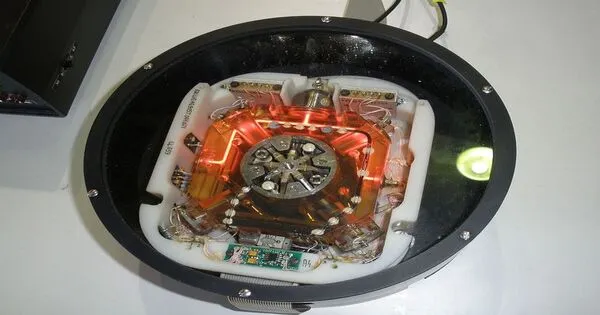A ring laser gyroscope (RLG) is made up of a ring laser with two independent counter-propagating resonant modes traveling along the same route; the phase difference is utilized to determine rotation. It is a tool for determining angular velocity or rotation. It is extensively employed in navigation systems, inertial navigation units (INUs), and other applications that demand precise angular motion measurements. RLGs are well-known for their precision and dependability.
It works on the Sagnac effect concept, which alters the nulls of the internal standing wave pattern in response to angular rotation. Externally visible interference between counter-propagating beams causes motion in the standing wave pattern, indicating rotation.
Description
Macek and Davis exhibited the first experimental ring laser gyroscope in the United States in 1963. Following that, various groups throughout the world advanced ring-laser technology. Tens of thousands of RLGs are in use in inertial navigation systems, with great precision, less than 0.01°/hour bias uncertainty, and a mean time between failures in excess of 60,000 hours.
Ring laser gyroscopes can be employed as stable elements in an inertial reference system (for one degree of freedom each). When opposed to a normal spinning gyroscope, the advantage of employing an RLG is that there are no moving parts (apart from the dither motor assembly and laser-lock). This means there is no friction, removing a major source of drift. Furthermore, the complete device is tiny, lightweight, and extremely resilient, making it ideal for use in mobile systems such as aircraft, missiles, and satellites. The device, unlike a mechanical gyroscope, does not resist changes in orientation.
Here’s how a ring laser gyroscope works:
- Basic Principle: At its core, an RLG relies on the Sagnac effect, which is a fundamental principle in physics. The Sagnac effect occurs when light travels in a closed loop in opposite directions. When the loop is rotating, the time it takes for light to travel in one direction is different from the time it takes in the opposite direction.
- Light Paths: In an RLG, laser light is split into two counter-propagating beams that travel around a closed-loop optical path. These beams circulate within a hollow ring-shaped structure (hence the name “ring laser”).
- Interference Pattern: As the two beams of light circulate in opposite directions, they create an interference pattern. The interference pattern shifts when the entire apparatus is subjected to angular rotation due to the Sagnac effect. The shift in the interference pattern is directly proportional to the angular velocity of the device’s rotation.
- Measurement: By precisely measuring the shift in the interference pattern, the angular velocity or rotation rate of the device can be determined. This information can then be used for navigation or other purposes.
Application
Ring Laser Gyroscope (RLG) applications now include an embedded GPS capability to improve the accuracy of RLG Inertial Navigation Systems (INS) on military aircraft, commercial airliners, ships, and satellites. In most applications, these hybrid INS/GPS systems have superseded their mechanical equivalents.
















